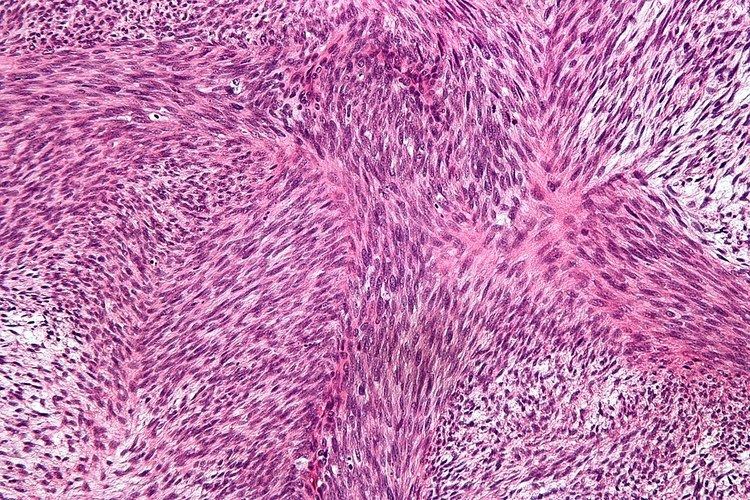Specialty oncology ICD-O M8810/3 | ICD-10 C49 (ILDS C49.M42) MeSH D005354 | |
 | ||
Fibrosarcoma (fibroblastic sarcoma) is a malignant mesenchymal tumour derived from fibrous connective tissue and characterized by the presence of immature proliferating fibroblasts or undifferentiated anaplastic spindle cells in a storiform pattern. It is usually found in males aged 30 to 40 . It originates in fibrous tissues of the bone and invades long or flat bones such as femur, tibia, and mandible. It also involves periosteum and overlying muscle.
Contents
Pathology
The tumor may present different degrees of differentiation: low grade (differentiated), intermediate malignancy and high malignancy (anaplastic). Depending on this differentiation, tumour cells may resemble mature fibroblasts (spindle-shaped), secreting collagen, with rare mitoses. These cells are arranged in short fascicles which split and merge, giving the appearance of "fish bone" known as a herringbone pattern. Poorly differentiated tumors consist in more atypical cells, pleomorphic, giant cells, multinucleated, numerous atypical mitoses and reduced collagen production. Presence of immature blood vessels (sarcomatous vessels lacking endothelial cells) favors the bloodstream metastasizing. There are many tumors in the differential diagnosis, including spindle cell melanoma, spindle cell squamous cell carcinoma, synovial sarcoma, leiomyosarcoma, malignant peripheral nerve sheath tumor and biphenotypic sinonasal sarcoma.
Adult-type
Individuals presenting with fibrosarcoma are usually adults aged thirty to fifty five years, often presenting with pain. In adults, males have a higher incidence for fibrosarcoma than females.
Infantile-type
In infants, fibrosarcoma is usually congenital. Infants presenting with fibrosarcoma usually do so in the first two years of their life.
Ancillary testing
Ancillary testing for fibrosarcoma includes IHC, where vimentin is positive, cytokeratin and S100 are negative, and actin is variable.
Fibrosarcoma in dogs and cats
Fibrosarcoma occurs most frequently in the mouth in dogs . The tumor is locally invasive, and often recurs following surgery . Radiation therapy and chemotherapy are also used in treatment. Fibrosarcoma is also a rare bone tumor in dogs.
In cats, fibrosarcoma occurs on the skin. It is also the most common vaccine-associated sarcoma. In 2014, Merial launched Oncept IL-2 in Europe for the management of such feline fibrosarcomas.
